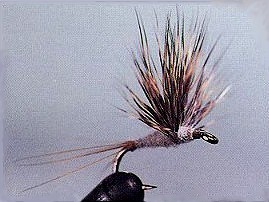
On The Fly
March 2011
"Fly tying is a school from which we never graduate"
TYING NEWS
The Southern Oregon Fly Tyers invite you to attend their meetings the second Tuesday
of each month. The next meeting is March 8, 2011. The meetings start at 6:00 PM, at the Madrone Hill
Mobile Home Park community building near Gold Hill. Bring a friend, come early so you don't miss anything,
and stay late. Tyers need not be experienced, and those with all levels of skill are welcome. Each meeting
a member is encouraged to demonstrate a new or different skill, from simple to difficult. For more
information, call Dan Kellogg at 773-4724.
JAY DALEY IS BACK !
Actually, Jay has been back for quite some time. But we'll finally be able to have Jay as our featured
demonstration tyer for March 8.
WIRE BODY STEELHEAD FLY
Jay will be tying this very striking Steelhead Fly that he calls a wire bodied fly. After the fly is tied,
it is coated with epoxy, which gives it a very shiny finish and makes it almost indestructible.
DIRECTIONS: Take Gold Hill Exit #40, off of I-5 and go west, toward Jacksonville, 1.3
miles, until you reach the brick entrance way to the Madrone Hill Mobile Home Park on the right. You’ll
pass a golf course parking lot on Your left shortly after leaving the freeway. After you turn right into the
mobile home park, proceed to the community building which is located about 100 yards ahead on the left. The
address is 8401 Old Stage Rd. Please park your vehicle on the bare dirt in the parking lot to avoid the
wooden septic covers in the grass.
PATTERN OF THE MONTH - March Brown Comparadun

Hook: Daiichi 1170, standard dry fly, size 14-10.
Thread: 8-0 tan.
Wing: Brown natural coastal deer hair.
Tail: Brown hackle fibers.
Abdomen and thorax: Tan Dubbing
Tying Instructions
Step 1 Mash the barb and mount the hook in the vise.
Step 2: Start the thread one eye width behind the eye and lay down an even thread base to a position just
above the hook barb. Return the thread to a position 1/3 the shank length behind the eye.
Step 3: Select a small bunch of deer hair, comb, stack, measure one shank length, and tie in the hair with
the tips pointing forward at the 1/3 point. Do not wrap so tight as to flair the hair. Push the wing down
around the hook shank so the hair is evenly distributed in the upper 180 degrees. Add a few more firm
thread wraps rearward to secure the hair in place,
Step 4: Trim the hair butts at an angle and bind them down with firm thread wraps. Form a small ball of
thread wraps at the bend of the hook just above the hook barb.
Step 5: Select a half dozen or so hackle fibers and tie them in on top of the hook shank just in front of
that thread ball. As you tie back towards the thread ball the hackle fibers will naturally want to separate
to either side. Give them some help with your thumb nail and secure with a couple firm wraps. You should
end up with a nicely tapered underbody. If not fill in with thread wraps.
Step 6: Twist dubbing onto the tying thread and wind forward to the base of the wing. With your thumb nail
crease the wing upright on top and both sides. Now draw the wing sharply back and firmly wrap your dubbed
thread in front of the wing to hold the wing in the upright position.
Step 7: Take two crisscross turns of dubbed thread under the wing and one more turn in front, then form a
neat head, whip finish and cement.
Step 8: Snip the center fibers out of the tail leaving a couple on each side.
In 1972, Al Caucci and Bob Nastasi introduced the Comparadun pattern to fly fishers in a
booklet entitled Comparahatch, distributed by Cortland. It was a remarkably simple and effective fly
equaling results attained by the classic Catskill style dry flies. The unique fan deer hair wing simulates
both the natural's wing and legs. The split tails add realism. The Comparadun is tied in many sizes and
colors to imitate any species of mayfly. For slow to moderate currents fish the Comparadun dead drift or
with a slight twitch if appropriate.
TYING TIPS
Many other types of deer hair are too spongy for a Comparadun wing. You don't want the
hair to flair, so spinning grade will not work well at all. This fly is a great example of why I advocate a
good thread base before starting most flies. Without the thread base, it is almost impossible to keep the
wing hairs from rotating down the side of the hook shank. By the time the fly is finished you will have a
360 degree wing.
Here it is, the dry fly you've been waiting for, three materials plus a hook and some
thread. It's easy to tie and once you learn the concept you can imitate any dry fly, any size, any color.
So tie some up, give them a test flight and let me know how you do.
Tie One On,
Dan Kellogg (you can contact me at FLYGUY@EZNORTHWEST.COM)